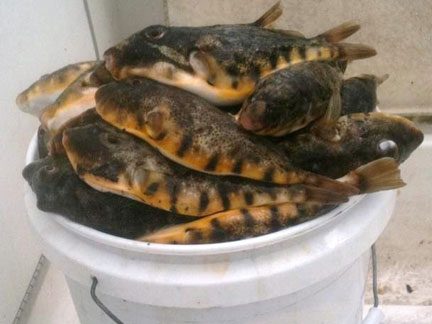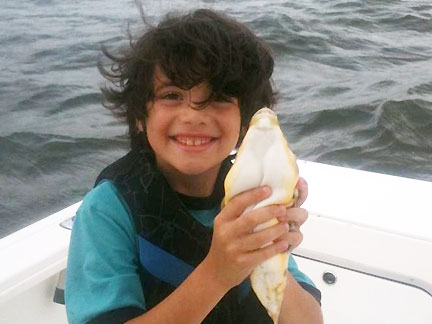

The northern puffer is to some an unattractive offering;
But to others, they are a gift from above...
By Bob Misak
The Ugly Duckling...
The Northern Puffer in past years has been what the local fishermen of central New Jersey called a cycle fish, or a species that comes and goes in cycles, only returning on an average of three to seven years. It wasn't long ago, when anglers would relish the time when the "blowfish came back".
As a youngster I was always chasing down those puffers, and the method of harvest wasn't exactly a rod and reel thing back then. We used frog spears and most bait shops had them in stock when the blowfish were here. If we ran low on cash, we sharpened a nail head and hammered it into the end of a broomstick handle as a spear. There were an ungodly number of puffers in the bay back then, and folks would put bunkers or chicken parts into a crab trap and catch three puffers or more per pull. It was blowfish free-for-all, in short.
Today, the ugly beast of the bay has returned, and in the last five years, it has blessed us with large numbers of good-sized fish. But catching puffers regularly does take a little effort. If you know the right way to fish for them, you can fill the boat with puffers in a short period of time. With that, you reap the benefits of a great eating fish, and a good fish to target when the fluke are finicky and the blackfish season has shut down.
 |
| Catches of blowfish like this only require a trip or two to fill the freezer. |
Chum blocks, mini-hooks, and a full bucket
The real hub of the blowfishing here in New Jersey is in good old Barnegat Bay. The bay blowfishing has seen stellar numbers of puffers in past years and now are being targeted by charter boats and large groups as word spreads of how good eating puffers are. Their numbers are such that it is doubtful that they will be over fished as some folks still have an issue with puffers being toxic. However, in the northeastern part of the country there has never been a report of puffer poisoning, so until there is, certainly there is absolutely no cause for alarm.
The water conditions for catching puffers should be clean water and a running tide. Though blowfish will follow your chum slick as it disperses, sight feeding is important in most situations, so you want to look for a clean day, and with that a running tide, either incoming or outgoing. With algae blooms coming and going for a good part of the summer, it's best to get the time down where the brown goo is at a minimum, and the last four hours of the outgoing water has typically been a stellar time to go fishing.
Chumming is really a must for getting any kind of solid response from blowfish; I like to go out with a minimum of six blocks of clam chum and a good, weighted chum pot. Once the chum begins working, you'll know. Once you run low on chum, you'll also know. I try not to let the chum run low, keeping the fish around the boat until the time I leave. The warmer the water gets, the more chum you should bring as the summer progresses. It's not often, but at times we will go through ten chum logs to get our fish in the box. And what I mean by fish is that you could essentially catch over a hundred puffers in a trip, even if you throw small ones back. With three or four anglers on your boat, it will be a good day of fishing for each to take home 20 or 25 puffers.
To hook puffers I like to go small, like real small. I use number eight or even 10 Gamakatsu hooks, either red or not. Puffers are, like blackfish, an expert bait thief, and to hook them one must feel their tiny little hits, sort of like a scratching coming up your line. With that, I lift and don't try to set the hook; I let the weight of the fat little bugger hook himself. After catching ten or twelve blowfish, they'll steal the hook or break it, and I keep plenty of rigs on hand for quick changing. A pair of pliers could help you remove hooks a bit quicker too, as they are small and tend to hurt the fingers after some time. The sinkers I use are less than one ounce, or one ounce if you want to ensure that you are on the bottom. A taut line, fresh clam strips for bait, and a little persistence, and you'll be nailing puffers so fast you won't have time to eat that "sub" you brought!
 |
| Ben Schneider shows off a giant blowfish; one of the many trips Ben has logged with his dad, Sander |
Now for the bad news...
As delicious as puffers are for eating, they are a chore to get cleaned, and that's just a complete understatement. Their skins are rugged and will act as a skin remover for the hands of even the veteran. A nail pounded into a board and the puffer impaled on it to hold it for skinning was very popular in the olden days and is still the method used by some today. But the new age angler has found more "pain-friendly" ways of skinning puffers.
Check your local bait and tackle shop for a pair of metal "fish skinners". This tool is used to grab the meat of the fish instead of the skin, and pulling it out, producing a clean, gut free fillet. Some (like me!) cut around the head and use a neoprene glove to strip the puffer, causing the hands little discomfort. You can also find a number of videos on YouTube for cleaning and preparing puffers.
So, if you're at a lull in the season and the kids want to catch fish... go buy a mess of chum, some mini-hooks and a bunch of clams in the shell. You will, with a little persistence, reap the benefit of a full freezer of puffers to cook on a cold, rainy day. But be nice to the puffer, don't let them go bad because cleaning them was too hard; don't keep the small ones, and let the puffer return each year in huge numbers to bless us with their presence. Good luck and great fishing!









